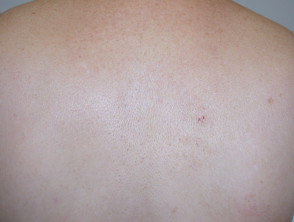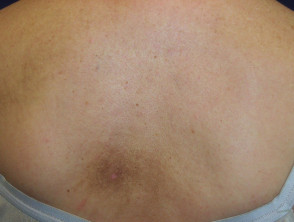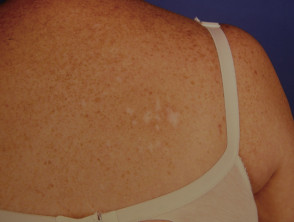What is notalgia paraesthetica?
Notalgia paraesthetica is a form of cutaneous dysaesthesia where itch and/or changed sensation arise in the areas of skin on the medial aspect of the shoulder blade on either side of the back. Notalgia means pain in the back, and paraesthetica refers to burning pain, tingling or itch.
It is also called thoracic cutaneous nerve entrapment syndrome.
The skin is itchy without a rash; however, scratching and rubbing can result in secondary changes such as eczema.
What is the cause of notalgia paraesthetica?
The nerves which supply sensation to the upper back emerge from the spinal cord (2nd to 6th thoracic segments) and run a long course up through the thick muscles of the back. They make a right-angled turn before reaching the skin. The nerves appear to be vulnerable to compression or traction. Partial compression or injury leads to the symptoms.
The initial injury to the nerves may include:
- Back injury
- Herniated or 'slipped' disc
- Herpes zoster (shingles)
- Sunburn
- Myelopathy
- Small fibre neuropathy
What are the clinical features of notalgia paraesthetica?
Notalgia paraesthetica often starts after a period of intense exercise leading to muscular stiffness, or a period of inactivity. A specific injury may be recalled.
It is characterised by intense itch (pruritus) on the medial border of one scapula or both, ie, between the shoulder blades. This itch can be intermittent or continuous. It is unrelieved by scratching, although the scratching and rubbing may be pleasurable.
The affected area may spread to both shoulder blades and more widely over the back and shoulders. In many patients, there are no visible signs.
Visible changes often arise from rubbing and scratching the affected area. These include:
- Scratch marks
- Hyperpigmentation (brown marks)
- >Hypopigmentation (white marks)
- Lichen simplex (a type of eczema)
- Scarring
There may be changed sensation in the affected area of skin, when this is tested for with pinprick, cotton wool or heat and cold. There may be reduced or absent sweating in the affected area.
Notalgia paraesthetica
What investigations should be performed in notalgia paraesthetica?
Radiology such as X-ray, CT scan or MRI may demonstrate a degenerative vertebra or prolapsed disc in the area that corresponds to the nerve supply to the affected skin (the dermatome). In many cases, no abnormality is revealed.
A skin biopsy will be reported as normal unless there is superimposed dermatitis.
What is the treatment of notalgia paraesthetica?
Treatment is not always necessary, and it is not always successful. Typical management may include the following:
- Cooling lotions or creams as required (camphor and menthol)
- Topical steroids to treat associated lichen simplex
- Capsaicin cream – this depletes nerve endings of their chemical transmitters but requires frequent reapplication and causes unpleasant local side effects
- Local anaesthetic creams may provide temporary relief of symptoms
- Amitriptyline or other oral tricyclic at night to help sleep and counteract neuropathic symptoms
- Gabapentin>, pregabalin or other anticonvulsant
- Botulinum toxin has been used but a double-blind trial indicated it was not effective
- Transcutaneous electrical nerve stimulation (TENS)
- Surgical decompression of vertebral nerve impingement
Physical therapy with repetitive exercises and stretches for the upper back has been reported to be effective.
- While sitting, cross arms and bend forward to stretch the upper back.
- Arms at sides, raise shoulders and rotate them forwards and backwards.
- Arms straight, rotate forwards 360 degrees and backwards 360 degrees.
- >Rotate upper body left and right until a stretch is felt and hold.
- Massage the muscles besides the spine in the affected area.


